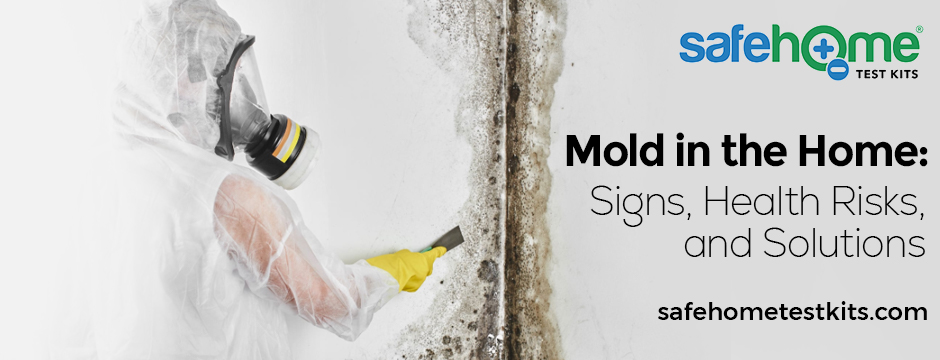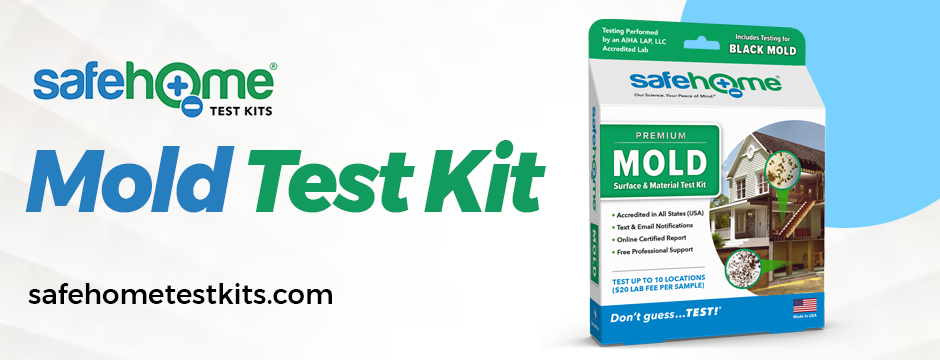Mold in the Home: Signs, Health Risks, and Solutions

Mold is an unwelcome intruder that can silently invade your home, threatening your property and health. As a homeowner or renter, it’s essential to be aware of the signs of mold, understand the potential health risks, and know the mold testing solutions to prevent mold growth. In this comprehensive guide, we’ll explore the world of household mold, covering everything from its telltale signs to effective solutions, empowering you to protect your home and loved ones.
Understanding Mold
Mold is a type of fungus that thrives in damp, humid conditions. It reproduces by releasing tiny spores into the air, which can settle on various surfaces and begin to grow under the right conditions. While mold plays a crucial role in nature by breaking down organic matter, it becomes problematic when it infiltrates our indoor environments.
Common Types of Household Mold
Several types of mold can colonize your home, but some are more prevalent than others:
- Stachybotrys Chartarum (Black Mold): Known for its dark green-black appearance, this mold is infamous for producing mycotoxins that can harm humans when ingested or inhaled.
- Aspergillus: This genus includes numerous species of mold, some of which can produce mycotoxins and cause respiratory issues.
- Cladosporium: Often found on fabrics and porous materials, Cladosporium can cause allergies and skin irritation.
- Penicillium: This mold can grow on various surfaces and produce mycotoxins, triggering allergic reactions and respiratory problems.
- Alternaria: Typically found in damp areas like bathrooms, this mold can cause allergies and asthma-like symptoms.
Signs of Mold in Your Home
Identifying mold in your home is essential for taking prompt action. Here are common signs to watch out for:
1. Visible Mold Growth
The most obvious sign is the presence of visible mold on walls, ceilings, floors, or other surfaces. Mold can appear in various colors, including black, green, white, or brown.
2. Musty Odor
A persistent, musty odor in a particular area of your home can strongly indicate hidden mold growth.
3. Water Leaks or Damage
Any history of water leaks, flooding, or water damage in your home increases the likelihood of mold growth, even if it’s not immediately visible.
4. Health Symptoms
Recurring health issues such as coughing, sneezing, nasal congestion, skin rashes, or eye irritation in your family members or pets may suggest mold-related health concerns.
5. High Humidity
Homes with consistently high humidity levels, especially in areas like bathrooms and basements, are more prone to mold growth.
Health Risks Associated with Mold
Mold can have various health effects, especially for individuals with allergies, asthma, or compromised immune systems. The health risks associated with mold exposure include:
- Respiratory Problems: Mold spores can be inhaled, leading to respiratory issues such as coughing, wheezing, and worsening asthma symptoms.
- Allergies: Mold can trigger allergic reactions, including sneezing, runny nose, itchy eyes, and skin irritation.
- Infections: Some mold species can cause infections in individuals with weakened immune systems.
- Mycotoxins: Mycotoxins produced by certain molds can lead to more severe health problems when ingested or inhaled, such as headaches, fatigue, and neurological symptoms.

Preventing Mold Growth: Key Strategies for a Mold-Free Home
Mold prevention is a proactive and cost-effective approach to maintaining a mold-free home. By implementing the following strategies, you can significantly reduce the risk of mold growth and its associated problems:
1. Control Moisture:
Mold thrives in damp environments, making moisture control crucial. Promptly fix any water leaks or plumbing issues to eliminate potential sources of moisture. Use dehumidifiers in areas prone to high humidity, such as basements and bathrooms. Ensure proper ventilation in kitchens and bathrooms to reduce humidity levels.
2. Maintain Indoor Humidity:
Keeping indoor humidity levels below 60% is essential for inhibiting mold growth. Use air conditioners and exhaust fans as needed, especially during humid seasons. Monitoring and regulating indoor humidity can be done with the help of hygrometers readily available at most hardware stores.
3. Proper Insulation:
Proper insulation helps prevent condensation on walls, ceilings, and windows, as condensation can create ideal conditions for mold growth. Insulate your home effectively to minimize temperature fluctuations leading to moisture buildup.
4. Regular Cleaning:
Routine cleaning is a fundamental part of mold prevention. Pay special attention to areas where mold is most likely to grow, such as bathrooms, basements, and kitchens. Dust and vacuum regularly to remove potential food sources for mold, like dust and organic debris.
5. Proper Ventilation:
Promoting proper airflow in your home is crucial. Use exhaust fans in bathrooms and kitchens to remove excess moisture and odors. Open windows when weather permits to allow fresh air to circulate through your home. Consider using air purifiers equipped with HEPA filters to help remove airborne particles, including mold spores.
6. Monitor Indoor Plants:
While indoor plants can enhance the aesthetics of your home, be cautious about mold growth in the soil. Ensure proper drainage by using pots with drainage holes and emptying saucers regularly. Additionally, provide adequate ventilation around potted plants to prevent excess moisture buildup.
Mold Remediation: Taking Action Against Mold
Discovering mold in your home requires swift and effective action. Mold remediation involves a series of steps to ensure the safe and thorough removal of mold:
1. Identify the Source:
Determining the source of moisture that is fueling mold growth is the first step. Addressing and rectifying the source of moisture is crucial to prevent further infestations.
2. Isolate the Area:
To prevent mold spores from spreading to other parts of your home, isolate the affected area. Seal it off with plastic sheeting and tape, creating a containment barrier.
3. Use Personal Protective Equipment (PPE):
When dealing with mold, safety is paramount. Wear appropriate personal protective equipment, including gloves, goggles, and an N95 respirator mask, to protect yourself from exposure to mold spores and contaminants.
4. Clean and Remove Mold:
Clean the affected surfaces using a mixture of water and detergent. Consider consulting a professional mold remediation service for larger infestations or if the mold is deeply embedded. They have the expertise and equipment to ensure thorough mold removal.
5. Replace Contaminated Materials:
In severe contamination, such as mold-infested drywall or insulation, removing and replacing these materials may be necessary to eliminate the mold source.
6. Prevent Future Growth:
After completing the remediation process, take steps to prevent future mold growth. Address any remaining moisture issues, improve ventilation, and continue to monitor for signs of mold in your home.

The Premium Mold Test Kit: Your Comprehensive Solution for Mold Detection
When it comes to mold detection in your home, knowledge is power. The Premium Mold Test Kit is your all-inclusive solution, equipping you with everything you need for sample collection, convenient shipping, and comprehensive testing conducted by our accredited laboratory. Whether you’re a homeowner, contractor, or home inspector, this kit ensures accurate and reliable results, empowering you to take control of mold detection and maintain a healthy living environment.
AIHA LAP, LLC Accreditation: Rigorous Standards for Peace of Mind
Our laboratory holds AIHA LAP, LLC accreditation in all 50 states for mold testing. This accreditation signifies that our testing meets the rigorous requirements for various scenarios, including home inspections, mortgage loans, and real estate closings. With the Premium Mold Test Kit, you can have confidence in the accuracy and reliability of the results, knowing that they adhere to the highest industry standards.
Identify and Address Mold Issues with Confidence
Mold issues in your home can be a cause for concern, affecting not only your property but also the health and well-being of your family. With the Premium Mold Test Kit, you can proactively identify and address mold problems, allowing you to take the necessary steps to create a healthy living environment for yourself and your loved ones.
Don’t leave mold detection to chance; take control of your indoor air quality with Safe Home® and our Premium Mold Test Kit. It’s your reliable partner in safeguarding your home and ensuring peace of mind regarding mold issues.
Conclusion
Mold is a household intruder that demands vigilance. By understanding the signs of mold, the health risks it poses, and effective prevention and remediation strategies, you can protect your home and loved ones from the harmful effects of mold. A mold-free home is a healthier place to live and a sanctuary of peace and well-being for you and your family.


